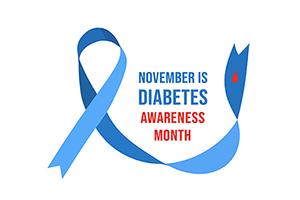It’s National Diabetes Awareness Month.The National Institute for Diabetes and Digestive and Kidney Disease informs us that 34.2 million Americans suffer from diabetes. Disconcertingly, a high percentage—21.4%—are not yet aware of it. But that’s just the tip of the iceberg.
An additional 88 million US adults (that’s 34.5% of the population over 18) are categorized as prediabetic, and 90% don’t know it. That means that they have borderline hemoglobin A1c, ranging from 5.8 to 6.4. Other features of prediabetes are an elevated waist to hip ratio (>1.0 in males or >.85 in females), triglycerides over 150, and fasting blood sugar 100-125. It’s almost certain that if your waist size is 40 inches or greater, you’ve got prediabetes.
Diabetes doesn’t usually kill you on its own. Only rarely do people succumb to a dreaded complication of out-of-control blood sugar, diabetic ketoacidosis.
But diabetics die disproportionately of heart disease and stroke, and certain cancers are more prevalent even in prediabetics. The metabolic syndrome that accompanies non-insulin dependent diabetes—the more common kind that affects overweight Americans—is a harbinger of eye problems, inflammatory conditions like arthritis and psoriasis, and even predisposes to dementia and Alzheimer’s. Not to mention ED, peripheral neuropathy, kidney failure and claudication.
And, alarmingly, the theme of this year’s Diabetes Month is an outreach to kids and adolescents, an escalating trend.
COVID-19 adds especial urgency to a call-to-action for diabetes. It was recognized early in the pandemic that elevated blood sugar—even in patients not previously diagnosed with diabetes—can worsen outcomes of SARS-CoV-2 infections. The results showed that patients in the highest fasting blood glucose group were 2.3 times more likely to die than those in the lowest. Even patients with prediabetes were 71% more likely to succumb. Before the advent of new therapeutics, 10% of hospitalized diabetic patients died within a week.
The good news is that just 5-8 pounds of weight loss nearly halves the risk of diabetes. Small changes to lifestyle, comprising diet and physical activity, prevented 40-47% of prediabetics in East Anglia, UK from progressing to full-blown diabetes, according to a large early-intervention trial.
But dietary recommendations for diabetes treatment and prevention remain hopelessly muddled. The American Diabetes Association persists in encouraging “moderate” consumption of carbohydrates:
“When it comes to choosing foods with carbs, the goal is to choose carbs that are nutrient-dense, which means they are rich in fiber, vitamins and minerals, and low in added sugars, sodium and unhealthy fats.”
By that they mean saturated fats, which they continue to demonize, despite evidence to the contrary. Their menus include beef stroganoff with noodles, oatmeal pecan pancakes, and “mini peach crisps”. They tell you to have plenty of fresh fruit, low-fat dairy, whole grains, and refined canola, corn, safflower, and sunflower oils.
This notwithstanding emerging evidence that very low-carb, and even ketogenic diets, can reverse Type 2 diabetes. A 2019 meta-analysis shows low glycemic index diets “may be useful for glycemic control and may reduce body weight in people with prediabetes or diabetes”.
Yet the health.gov website posits: “ . . . diets with a range of carbohydrate content, from very low-carbohydrate to moderate-carbohydrate to high-carbohydrate vegan diets, help control blood glucose.” This is what happens when the Dietary Guidelines are written by committee, with members beholden to various food industry interests.
Nowhere is it noted, in light of cutting-edge research, that the timing of food consumption is crucial to blood sugar response. A recent study showed that just two weeks of time-restricted feeding improved insulin response.
Other simple lifestyle modifications with practical implications for diabetes prevention and reversal:
- Chemicals cause diabetes. UC Riverside researchers found that PBDEs, so-called “forever chemicals” used as flame retardants and found in nearly every American home, cause mice to give birth to offspring who are diabetic.
- Green tea and coffee reduce mortality risk in Type 2 diabetes. A Japanese study found that drinking four or more cups of green tea per day lowered death risk by 40%; there was a 63% lower risk for those consuming four or more cups of green tea plus two or more cups of coffee daily.
- Embrace the cold. A study found that short term cold exposure—just 10 days of “cold acclimation” at moderate temperatures around 55 degrees—increased insulin sensitivity by 43% in diabetic subjects.
- Walk after eating. Even if you can’t do 10,000 steps, a recent study showed that three short bouts of walking (15 minutes) after meals improved glycemic control even better than a longer, sustained 45-minute walk.
- Sleep longer. It’s well known that sleep deprivation disrupts insulin signaling and increases appetite.
The lack of focus on lifestyle interventions is surely a missed opportunity. Diabetes drugs proliferate, but there is little evidence that strict blood-sugar control prevents health problems linked with diabetes. In fact, one classic study even showed that excess blood-sugar lowering via the pharmaceutical route can increase the likelihood of death.
We can do better. Via a comprehensive lifestyle intervention approach, we can stave off diabetes, and even normalize blood sugars in non-insulin-dependent diabetics.







